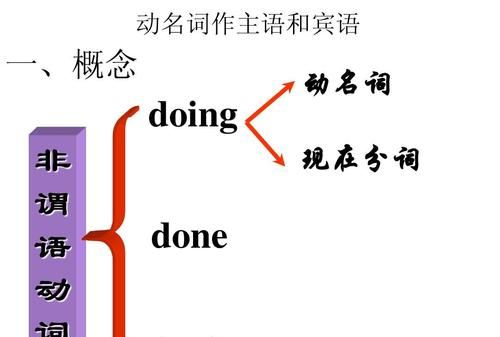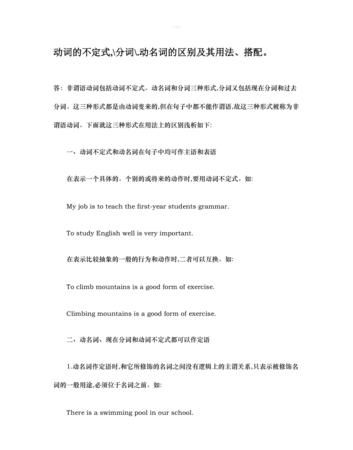本文目录
动名词做定语是什么词性
动名词做定语举例是:
1.动名词作定语,说明被修饰词的性质、特征或用途。如:
He may be in the reading room.
他可能在阅览室里。
They set up an operating table.
他们搭起一个手术台。

2.动名词作定语,表示其与被修饰词之间为主动关系,并且表示动作正在进行。如:
There are about 200 students studying in this school.
大约有200个学生在这个学校学习。
Who is the woman talking to our English teacher?
正在和我们英语老师谈话的那个女人是谁?
3.有些动名词已经转化成了形容词,常用作定语修饰物,表示“令人……”
That must be a terrifying experience.
那肯定是一次可怕的经历。
The experiment was an amazing success.
那实验是一个惊人的成功。
英语定语从句
定语 概述定语是用来修饰、限定、说明名词或代词的品质与特征的。 主要有形容词此外还有名词、代词、数词、介词短语、动词不定式(短语)、分词、定语从句或相当于形容词的词、短语或句子都可以作定语。 汉语中常用‘……的’表示。定语和中心语之间是修饰和被修饰、限制和被限制的关系。在汉语中,中心语与定语二者之间有的需要用结构助词“的”,有的不需要,有的可要可不要。 “的”是定语的标志。 英语中的定语 The little boy needs a blue pen.(little修饰名词boy;blue修饰名词pen.)/小男孩需要一支蓝色的钢笔。
Tom is a handsome boy./Tom是个英俊的男孩。
There is a good boy./有个乖男孩。
数词作定语相当于形容词:Two boys need two pens./两个男孩需要两支钢笔。
The two boys are students./这两个男孩是学生。
There are two boys in the room./房间里有两个男孩。
代词或名词所有格作定语:
His boy needs Tom's pen./他的男孩需要Tom的钢笔。
His name is Tom./他的名字是汤姆。
There are two boys of Tom's there./那儿有Tom家的两个男孩。
介词短语作定语:
The boy in the classroom needs a pen of yours./教室里的男孩需要你的一支钢笔。
The boy in blue is Tom./穿蓝色衣服的孩子是汤姆。
There are two boys of 9,and three of 10./有两个9岁的,三个10岁的男孩。
名词作定语:
The boy needs a ball pen./男孩需要一支圆珠笔。
It is a ball pen./这是一支圆珠笔。
There is only one ball pen in the pencil box./这铅笔盒里只有一支圆珠笔。
副词作定语:
The boy there needs a pen./那儿的男孩需要一支钢笔。
The best boy here is Tom./这里最棒的男孩是Tom。
不定式作定语:
The boy to write this letter needs a pen./写这封信的男孩需要一支钢笔。
The boy to write this letter is Tom./将要写这封信的男孩是汤姆。
There is nothing to do today./今天没有事要做。
分词(短语)作定语:
The smiling boy needs a pen bought by his mother./那个微笑的男孩需要一支他妈妈买的钢笔。
The pen bought by her is made in China./她买的笔是中国产的。
There are five boys left./有五个留下的男孩。
定语从句:
The boy who is reading needs the pen which you bought yesterday./那个在阅读的男孩需要你昨天买的钢笔。
The boy you will know is Tom./你将认识的男孩叫汤姆。
There are five boys who will play the game./参加游戏的男孩有五个。
定语的位置一般有两种:用在所修饰词之前的叫前置定语,用在所修饰词之后的叫后置定语。
单词作定语时通常放在它所修饰的词之前,作前置定语。短语和从句作定语时则放在所修饰的词之后,作后置定语。
1)定语前置
在英语里,一般定语前置时的次序为:限定词,形容词、分词、动名词和名词性定语。但当几个形容词同时出现在名词短语之前,我们要注意其次序。其形容词遵循的词序为:限观形龄色国材,指:限定词(一般指数量);外观(美丽等);形状(大小,高矮,肥瘦);年龄;颜色;国籍;材料;用途。如:
1限定词 2 外观 3形状 4年龄 5颜色 6国籍 7材料 8用途
A famous American university.
An interesting little red French oil painting.
A new plastic bucket.
A purple velvet curtains
An elegant German clock
另外,有些形容词也有特殊的次序:
(1) 描述身体特征的形容词先于表示情感和性格特征的形容词
例如:a small lovely girl , a long patient queue , a pale anxious patient ;
(2) 表示颜色的形容词放在表示情感和性格特征的形容词之后
例如:a kindly black teacher ,an inquisitive brown dog ;
(3) little ,old 和young 有时可以作为名词短语不可分割的一部分,所以可以直接放在名词之前,
例如:a lovely little girl
(4) 表示性格特征的形容词可以放在old young 之前,也可放在old young 之后,例如:
a young ambitious man (强调年龄) ,an ambitious young man(强调雄心勃勃) 。
当然,三个以上形容词连用作定语,就显得累赘,因此上面所说的情况一般较少出现.
2)定语后置
(1)短语作定语一般后置
It was a conference fruitful of results. 那是一个硕果累累的会议。
He gave me a basket full of eggs. 他给我一个装满鸡蛋的篮子。
English is a language easy to learn but difficult to master. 英语是一门容易学但是难精通的语言。
The boys hardest to teach are all in his class.最难教的男生都在他的班里了。
(2)修饰some,any,no,every等词构成的不定代词的定语都后置
Let’s go somewhere quiet. 咱们去找个安静一点的地方吧。
There is nothing important in today's newspaper. 今天报纸上没有什么重要的东西。
Do you have anything more to say? 你还有什么话要说吗?
(3)副词作定语
The people here are very friendly. 这里的人很友好。
They lived in the room above.他们住在楼上的房间。
(4)动词、名词转化而来的以-able,-ible 结尾的形容词作定语
He is a person dependable. 他是一个可以依靠的人
This is the only transportation means available. 这是唯一可行的交通工具。
(5)起强调用的单个分词
Everybody involved should stay here.
The college mentioned.
(6)特殊词
Could you tell me something imporpant.
3) 定语从句
英语里有大量的定语从句,而汉语里却没有定语从句的说法。英语中定语从句中甚至还可能包含定语从句,即多重定语从句。如: A healthy diet includes enough but not too many kinds of foods that provide the body with the nutrients that it needs to function properly. (健康的饮食包括的食物应该充足但又不过多。这些食物提供身体正常活动所必需的营养)
(1)英语的复合句中,分句以其主句为基干,通过连接手段,一层一层地展开,就好像一棵树的树干上长出大枝子,大枝子上再长出小枝子。汉语的分句则更多按照时间发生的顺序出现,依次展开。
如: “伟大领袖和导师毛主席领导中国共产党进行了艰苦卓绝的斗争,建立了新中国,人民得到了解放,科学得到了解放。”这句话,译成英语便成了With the founding of new China (which was) born of arduous struggles (which were) waged by the Chinese Communist Party (which was) under the leadership of our great leader and teacher Chairman Mao , our people , and science as well , won emancipation.(王良兰,2003)
(2)英语中的非限制性定语从句所表达的信息,在汉语里一般由另一个小句来表达。用非限制性定语从句时,前应加逗号,并且非限制性定语从句引导词只能用which,不能用that。
例如:She asked for his help which he gladly gave. 她要求他帮忙,他愉快地帮助了她。
再如: It was a century during which the country suffered continuously from wars.
一个世纪过去了,在这期间这个国家不断遭受战乱之苦。 动名词 动名词是一种兼有动词和名词特征的非限定动词。它可以支配宾语,也能被副词修饰。动名词有时态和语态的变化。
解释:动词的ing形式如果是名词,这个词称动名词。
特征:动词原形+ing构成,具有名词,动词一些特征动名词具有名词的性质,因此在句中可以作主语、表语、宾语、定语等。
1、作主语
Reading is an art. 读书是一种艺术。
Climbing mountains is really fun. 爬山是真有趣。
Working in these conditions is not a pleasure but a suffer. 在这种工作条件下工作不是愉快而是痛苦。
动名词作主语,有时先用it作形式主语,把动名词置于句末。这种用法在习惯句型中常用。如:
It is no use/no good crying over spilt milk. 洒掉的牛奶哭也没用。
It is a waste of time persuading such a person to join us. 劝说这样的人加入真是浪费时间。
It was hard getting on the crowded street car. 上这种拥挤的车真难。
It is fun playing with children. 和孩子们一起玩真好。
There is no joking about such matters. 对这种事情不是开玩笑。
动名词作主语的几种类型
动名词可以在句子中充当名词所能充当的多种句子成分。在这里仅就动名词在句子中作主语的情况进行讨论。
动名词作主语有如下几种常见情况:
1. 直接位于句首做主语。例如:
Swimming is a good sport in summer.
2. 用 it 作形式主语,把动名词(真实主语)置于句尾作后置主语。
动名词做主语时,不太常用 it 作先行主语,多见于某些形容词及名词之后。例如:
It is no use telling him not to worry.
常见的能用于这种结构的形容词还有:better,wonderful,enjoyable,interesting,foolish,difficult,useless,senseless,worthwhile,等。
注意:important,essential,necessary 等形容词不能用于上述结构。
3. 用于“There be”结构中。例如:
There is no saying when he'll come.很难说他何时回来。
4. 用于布告形式的省略结构中。例如:
No smoking ( =No smoking is allowed (here) ). (禁止吸烟)
No parking. (禁止停车)
5. 动名词的复合结构作主语
当动名词有自己的逻辑主语时,常可以在前面加上一个名词或代词的所有格,构成动名词的复合结构(——这时,名词或代词的所有格做动名词的逻辑主语)。动名词的复合结构也可以在句中作主语。例如:
Their coming to help was a great encouragement to us.
6.例词
shopping fishing cycling这些都是很常见的动名词
二、动名词作主语与动词不定式作主语的比较
动词不定式和动名词都可以用作主语。在意义上相近。但动名词多用来表示泛指或抽象动作,不定式多用来表示特指或具体动作。比较:
Smoking is not good for health.
It is not good for you to smoke so much.
注意:
1)在口语中,用动名词作主语位于句首的较不定式多见。
2)在“It is no use...”,“It is no good...”,“It is fun...”,“It is a waste of time...”等句型中,通常用动名词作真实主语:
It is no use/good/a waste of time talking about that.
*It is no use/good/a waste of time to talk about that.
3)在疑问句中,通常用动名词的复合结构,而不用不定式的复合结构作主语:
Does your saying that mean anything to him?
*Does for you to say that mean anything to him?
4)在“There be”句型中,只能用动名词,而不能用不定式作主语:
There is no telling what will happen.
It is impossible to tell what will happen.
5)当句子中的主语和表语都是非限定动词时,要遵循前后一致的原则,主语和表语在形式上要求统一:
Seeing is believing.
*To see is to believe.
2、作宾语
(1)作动词的宾语
某些动词后出现非限定性动词时只能用动名词作宾语,不能用不定式。常见的此类动词有:advise, allow, permit, avoid, consider, enjoy, finish, give up, cannot help, imagine, include, keep, keep on, mind, miss, put off, delay, practise, resist, suggest, depend on, think about, set about, succeed in, worry about, burst out, insist on, can’t stand, be used to, get used to, devote…to…, look forward to, pay attention to, get down to,escape 等。如:
They went on walking and never stopped talking.
他们继续走,说个不停。
I found it pleasant walking along the seashore.
在海滩上走真是乐事。
Mark often attempts to escape being fined whenever he breaks traffic regulations.
每当马克违反交通规则时,他常常企图逃避罚款的处分。
(2)作介词的宾语
We are thinking of making a new plan for the next term. 我们正考虑为下学期制定新的计划。
Shall we have a rest or get down to doing our work? 我们休息呢还是开始干活?
(3)作形容词的宾语
The music is well worth listening to more than once. 这种曲子很值得多听几遍。
We are busy preparing for the coming sports meet. 我们正为马上到来的运动会忙着做准备。
3、作表语
动名词作表语时句子主语常是表示无生命的事物的名词或what引导的名词性从句。表语动名词与主语通常是对等的关系,表示主语的内容,主语、表语可互换位置。
Your task is cleaning the windows. 你的任务就是擦窗户。(Cleaning the windows is your task.)
What I hate most is being laughed at. 我最痛恨的就是被别人嘲笑。 (Being laughed at is what I hate most.)
4、作定语
动名词作定语往往表示被修饰词的某种用途。如:
a walking stick =a stick for walking=a stick which is used for walking
a washing machine=a machine for washing=a machine which is used for washing
a reading room=a room for reading=a room which is used for reading
a measuring tape=a tape for measuring=a tape which is used for measuring
sleeping pills=pills for sleeping=pills which is used for sleeping

动名词做定语举例
动名词作定语时,在句子中通常有两个位置:如果是单个的动名词作定语,常放在被修饰的名词前面作前置定语;如果是动名词短语作定语,则放在被修饰名词的后面,作后置定语。
1.动名词作定语,说明被修饰词的性质、特征或用途。
He may be in the reading room. 他可能在阅览室里。
They set up an operating table. 他们搭起一个手术台。
2.动名词作定语,表示其与被修饰词之间为主动关系,并且表示动作正在进行。
There are about 200 students studying in this school. 大约有200个学生在这个学校学习。
Who is the woman talking to our English teacher? 正在和我们英语老师谈话的那个女人是谁?
3.有些动名词已经转化成了形容词,常用作定语修饰物,表示“令人……”:exciting, shocking, puzzling, confusing, disappointing, discouraging, boring, tiring, moving, touching, interesting, satisfying, frightening, amazing等。
That must be a terrifying experience. 那肯定是一次可怕的经历。
The experiment was an amazing success. 那实验是一个惊人的成功。
注意:如果动名词与被修饰词之间是被动关系,就要用它的被动式being done,通常表示正在被做,常作后置定语。
The tall building being built now is our new school. 正在被修建的那建筑是我们的新学校。
That question being discussed was presented by the headmaster.
正在被讨论的那个问题是校长提出来的。

用动名词作定语造句英语
这类的词 在英语中就是名词,不是动名词定语 没有这个说法
动名词是加了ing的作名词形式的词才这么说
排气阀 vent valve 是名词词组
刨冰机 ice crusher 也是一样的

以上就是关于动名词做定语英文 ,动名词做定语是什么词性的全部内容,以及动名词做定语英文 的相关内容,希望能够帮到您。
